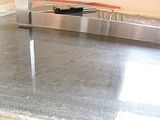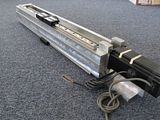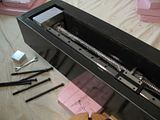Jack build away - really, i think its great the contribution to diy EG science you guys are making, but do you understand the commercial applications you reference, its modulus of elasticity, how section and modulus of elasticity effects rigidity, how cutting forces effect the structure and how vibration dampening works? I would not make a mill column or lathe bed of EG. I hope I'm wrong because then you've discovered and developed techniques for a wonderfully flexible diy build medium....however I've not received a response based in engineering that addresses the issues I raise. mostly responses are along the lines of we hope and wish it isn't so so we're going ahead anyway. you can design the base to suit the material - better however to include material selection as part of the design process. my point is to achieve a given rigidity with only EG, the size, weight and expense will be significantly higher than with steel and EG. do you refute that? actually, doesn't matter, stated my point, good luck with the build.
Results 2,421 to 2,440 of 5053
-
11-28-2007, 04:28 AM #2421
 Registered
Registered
- Join Date
- Mar 2005
- Posts
- 1136
-
11-28-2007, 04:28 AM #2422
 Gold Member
Gold Member
- Join Date
- May 2003
- Posts
- 792
-
11-28-2007, 04:43 AM #2423
 Gold Member
Gold Member
- Join Date
- May 2003
- Posts
- 792
Mcgyver, could you analyze this structure please: http://img526.imageshack.us/img526/6154/z1nd8.jpg
or this one: http://img265.imageshack.us/img265/5241/pictureaeq0.jpg
one more: http://img406.imageshack.us/img406/4161/minimillmj7.jpg
_
-
11-28-2007, 04:43 AM #2424
 Registered
Registered
- Join Date
- Jun 2005
- Posts
- 334
Mcgyver, I (or anyone else that I know of) never said you would not use reinforcement in EG.
Reinforcement can take many forms both internal and external. Walters picture shows reinforcement in the form of attachments embedded in the EG. Internally I doubt any such reinforcements exist.
-
11-28-2007, 04:51 AM #2425
 Registered
Registered
- Join Date
- Jul 2006
- Posts
- 1256
smoki'n
(flame2)(flame2)
Walter TT or S/P are for slow cure giving time to self level.1/8" is max per pour.Heat applied is after pour not before.Abeer or two will douse the fire.Hope I am not too late.
LarryL GALILEO THE EPOXY SURFACE PLATE IS FLAT
-
11-28-2007, 04:52 AM #2426
 Registered
Registered
- Join Date
- Jun 2005
- Posts
- 334
Use cheap beer!

-
11-28-2007, 04:55 AM #2427
 Registered
Registered
- Join Date
- Apr 2007
- Posts
- 777
Mcgyver,
You have made a good point with regards to modulus and also with regards to a knowledge management solution. We have taken care of the knowledge management solution as best we could by writing the epoxy granite index thread. I personally indexed most relevant posts from 1 up to about 1700 and the index thread contains links into the posts in the main thread via some software I wrote. (vbulletin could learn from this. . .)
As for modulus, you are absolutely right that an E/G machine may easily be heavier than a cast iron one. It must also be remembered that many cast iron machines are over designed from a strength and stiffness point of view to avoid being resonant.
I've personally done the deflection calculations for E/G with a 2000Ksi flexural modulus (which is 75% low according to the few tests we have now) and it looks like there should be no problem holding deflection to under .0001 inches in an 8x8 inch square E/G beam 24 inches long with a 100 lb load. The modulus can be lived with. For a machine base that is supported on the ends and in the middle, it shouldn't be a horrible problem except that casting such a behemouth for a diyer will be a challenge. Unfortunately, for much longer than 24 inches, extensive reinforcement will be required both to maintain .0001 static deflection and in larger cases to keep the machine from collapsing under its own weight.
I've got a brand new flexural tester on my kitchen table and the offer still stands that I'll test any set of five samples sized 1/2x3/8x7.5 inches for anyone here as a service to the community.
Anyway, you're right that an E/G machine will weigh more than a cast iron machine for the same rigidity. There won't be any sort of vibration problem however because the damping factor for E/G is 7 times that of steel.
I do have some tricks up my sleeve to greatly increase the modulus and with the impending completion of my home shop and the acquisition of an additional commercial building. Between what Jack has cooking and what I have cooking, I think some nice surprises may result. World look out once I start pouring epoxy!
Regards all,
Cameron
-
11-28-2007, 05:02 AM #2428
 Registered
Registered
- Join Date
- Jun 2005
- Posts
- 334
-
11-28-2007, 05:24 AM #2429
 Gold Member
Gold Member
- Join Date
- May 2003
- Posts
- 792
Cheap beer saved the day! :cheers:
Ok, back to business.
Not necessarily.
"Epoxy granite has been specifically designed for precision machine structures. [..] Epoxy granite overcomes many of the disadvantages of the conventional material, possesses most of the advantages, and, in some cases, significantly betters them. It is a cold curing mixture of binding agent, reaction resin and hardener, together with carefully selected, graded and mixed aggregates.
Epoxy concrete structures are made in two stages. Initially the base is cast in a low cost wooden or steel mould with light cores to direct the material into the optimum position for high structural stiffness-to-weight ratio. Electrical or coolant conduits are easily incorporated at this stage.
After curing (6 hours) of the main base, precision surfaces may be either grouted in or cast by replication technique using a precision replication tool and epoxy based low 'stick-slip' bearing material containing special additives. Accuracy of surface casting or replication is typically 1um per metre.
This material has an internal damping factor 10 times greater than that of cast iron and 3 times that of granite. It's overall cost is approx half that of cast iron in series production. It's specific gravity and E modulus are both about one-third that of cast iron so that comparable stiffness is obtainable by using thicker walled sections [..]"
(pdf from the 70's)
-
11-28-2007, 03:28 PM #2430
 Registered
Registered
- Join Date
- Mar 2005
- Posts
- 1136
Walter, those are good looking machines. However I have to say that it’s irrelevant.... this always happens, someone anecdotally pointing to an EG machine sayings, see it can be done. Of course it can be done. , and if those machines grind a billionth of an inch off a mirror and you're machining aluminum how does that they exist advance the discussion? I agree that it is good to look for design hints on other's successful work, however you need to assess how well aligned their design objectives and uses are to yours. Please cite what these machines are and do....I'm prepared to be wrong but my suspicion is that a pure EG machine is intended for extremely light cutting force at extreme accuracy, ie at optical levels. This is a logical assumption given they are using such a low modulus material - it says the machine is subjected to negligible stresses OR there is a massive internal steel reinforcing system that we just can't see.
More closely aligned with diy mill or router imo would be what machine tool manufactures do. they fill steel (one of custom stuff) or cast iron (production) sections primarily to reduce vibrations, although of course the EG also adds some rigidity.
You highlighted some quotes. any section will benefit from material being removed from the core to the outside, that’s why a vertical mill column is hollow. However that doesn't have anything to do with an EG machine being lighter or better than CI. A better design imo is to put the high modulus stuff (steel) on the outside and low modulus but better vibration dampening stuff inside. Cast iron I agree suffers a production constraint; who among us can pour a 1000 lb casting? Steel on the other hand is easily worked with and cheap.
What is the cost of the EG? This is an area I don’t know too much about. If it’s very inexpensive, it may be a valid argument to just use 3x as much of it to achieve the same rigidity. So long as it’s a lot cheaper than steel, and you are compensating for its lack of rigidity by using a lot more of it, I suppose I can’t argue
Cameron, agreed, the section can be made massive to compensate for the low Young's modulus, can't argue with that....however I question the design decision in the context of the objectives. If i were grinding mirrors to a millionth of an inch accuracy, I can see why a section of EG, many times the size of a steel section would be desirable. However for a mill or router which has much higher loads and lower accuracy requirements its seems a difficult position to argue replacing the main structural sections with material with 1/3 the rigidity. What is gained by moving from a stress relieved steel reinforced EG structure to EG (unless the EG is just sooo cheap)? Heavy, maybe more expensive, bulkier etc with no upside i - except that you don't have to learn how to weld. if that’s the case, then an EG only machine is a significant design compromise so suit a production constraint. The question then is it easier to learn to weld than ….
-
11-28-2007, 05:15 PM #2431
 Registered
Registered
- Join Date
- Apr 2007
- Posts
- 777
Mcgyver,
In the context of professional machines, the main reasons to use E/G are vibration damping (an order of magnitude better than cast iron) and replication.
Replication is the use of a precision mold to make a part that is accurate when demolded. Some sources cite accuracy in the microns when done properly. (DIYers will mostly not have sufficient mold making skill for true high accuracy replication).
In the DIY context, when we have the formula right and the production methods documented, E/G will provide an excellent vibration damping material which can be made in intricate shapes using molds that are made with wood or other materials. It should cost a bit less than a dollar a pound from what Walter and others have observed.
A design which uses E/G for damping and metal for structure is probably optimal for strength and material usage but you theoretically have the problem that the metal parts transmit vibrations like a fiber optic cable transmits light. (Very Rough analogy).
I assume that cutting forces are in the tens of pounds (correct me if I am wrong) and that the 8x8 beam in my previous post will easily hold .0001 to 100 lbs. There also should be less deflection induced by vibration than in a metal part.
We believe but won't know until our research is done that E/G will allow a minimally equipped DIYer to produce a basic small machine that is sufficiently rigid to cut metal using the self leveling property of epoxy to make the table flat to .0001.
I don't know what the current costs of suitable steel are. I am sure that a hybrid approach is probably desirable when it is available.
The goodness of E/G can't be decided yet as we don't have material properties for what we can actually make. Once we complete the study of material properties and sensitivity analysis, a much better discussion can be had.
Until we have real material properties, documented research of an order of magnitude better vibration damping and the ability to cast sizable parts without welding are the advantages of E/G over steel.
In short, I think that your arguments have a lot of merit but I don't think that there will be rigidity problems of the magnitude you allude to. When I discover that the modulus is equivalent to a wet spaghetti noodle, then I'll worry
-
11-28-2007, 09:59 PM #2432
 Gold Member
Gold Member
- Join Date
- May 2003
- Posts
- 792
Mikron HSM600, Monoblock Epoxy Composite Frame, True High Speed Machining, Feed Rate 1575ipm & 1.0g of Acceleration, Spindle max 32 kW http://img265.imageshack.us/img265/5241/pictureaeq0.jpg
They do use some sort of steel cage. We have the Mikron owners here on the Zone, maybe we could talk one into x-ray'ing his machine
* * *
Jack,
The meniscus problem is back:

Coat thickness seems to affect the meniscus. Could be something else, I don't know.
-
11-28-2007, 10:42 PM #2433
 Registered
Registered
- Join Date
- May 2007
- Posts
- 106
from the french document I've pointed:
Caractéristiques techniques comparatives
Propriétés Unité CELITH Granit Fonte
Masse volumique 3
Kg/dm 2.3 à 2.5 2.7 à 3 7.2
Résistance à la compression N/mm2 120 à 150 350 500
Résistance à la traction N/mm2 10 à 15 10 à 15 150 à 250
Module d’élasticité KN/mm2 30 à 40 35 à 45 90 à 120
Coefficient de dilatation thermique -6
10 /°C 9 à 13 5à7 10 à 13
Conductibilité thermique W/m.°C 1à3 2 50
D’où l’intérêt de choisir le CELITH plutôt que la fonte
Elesticity Modulus for commercial EG: 30 to 40 Kilo Newtons per square mm (equals giga Pascals)) (33% of cast Iron)
after ther is also
traction resistance: 10-15 GPa (<10% of cast Iron)
Compression resist. 120-150 GPa (25% of cast Iron)
but volumic mass is only 33% of cast Iron, so it must possible to make machines of the same weight and resistance that in cast Iron (think quadratic momentum is at power 2)
beside, I've missed something, Walter, are you trying to do a surface plate with liquid epoxy on concrete?
and I can spot metallic treaded inserts
where did you got them?
-
11-28-2007, 11:02 PM #2434
 Registered
Registered
- Join Date
- Jun 2005
- Posts
- 1436
Walter, I wonder if the meniscus problem is one of scale. Could it be that the edge effect you've shown in your photo might be the same size on a pour ten feet across, so the centre 99% is flat with a 1% edge effect ?
I hope this isn't the case, as I'm looking to use the surface pour approach for truing up my beams.
Perhaps Larry will give us his thoughts.
JohnIt's like doing jigsaw puzzles in the dark.
Enjoy today's problems, for tomorrow's may be worse.
-
11-28-2007, 11:30 PM #2435
 Registered
Registered
- Join Date
- Jul 2006
- Posts
- 1256
Jack& Walter,If meniscus is present can it be filled off.I assume a dam was used.Did you use a torch or paint stripping gun to release the air and lower the viscosity?Did you follow shopmanic's directions?I have never used TT with a dam,only over the edge which is messy.More detailed info would help on the technique used.
LarryL GALILEO THE EPOXY SURFACE PLATE IS FLAT
-
11-29-2007, 01:19 AM #2436
 Registered
Registered
- Join Date
- Jun 2005
- Posts
- 334
-
11-29-2007, 01:24 AM #2437
 Registered
Registered
- Join Date
- Jun 2005
- Posts
- 334
Oh your using TT epoxy. Hmmm now I want to know what you're casting on.
-
11-29-2007, 01:35 AM #2438
 Registered
Registered
- Join Date
- Jun 2005
- Posts
- 334
LOL Maybe it was repulsed by the cheap beer you threw on it!

At least TT has taste.
-
11-29-2007, 01:37 AM #2439
 Gold Member
Gold Member
- Join Date
- May 2003
- Posts
- 792
No time to answer.
Larry Help! The blob is just sitting there. How did you get 1/16" with TT epoxy?
Let me know, 10min left
-
11-29-2007, 02:17 AM #2440
 Registered
Registered
- Join Date
- Jul 2006
- Posts
- 1256
Walter spread it around with a brush then the torch and heat
L GALILEO THE EPOXY SURFACE PLATE IS FLAT
Similar Threads
-
Epoxy Granite In Practice (Mineral Casting, Polymer Concrete)
By johnohara in forum Epoxy GraniteReplies: 71Last Post: 08-25-2020, 01:18 PM -
Voice Your Opinion On "POLYMER CONCRETE FRAME" Thread!
By walter in forum PollsReplies: 14Last Post: 11-13-2015, 02:57 AM -
Epoxy granite (Mineral casting, Polymer concrete)---Particle size distribution
By Steven.ji in forum Epoxy GraniteReplies: 9Last Post: 01-15-2014, 11:39 AM -
Index to "Epoxy-Granite machine bases" thread
By walter in forum Epoxy GraniteReplies: 13Last Post: 12-02-2011, 05:45 AM -
Epoxy-Rice Machine Bases (was Polymer rice frame?)
By mdierolf in forum Mechanical Calculations/Engineering DesignReplies: 18Last Post: 11-02-2008, 04:16 AM






 Reply With Quote
Reply With Quote




